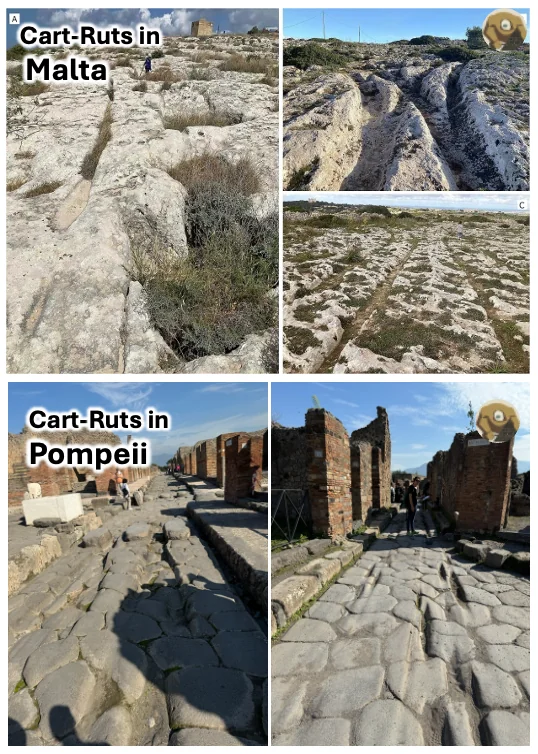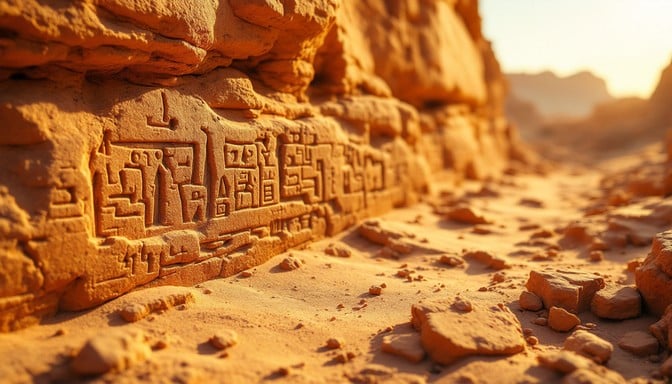All over the world—from the sun-baked rocks of Malta and the highlands of Turkey to the underwater formations near the Azores and even as far as Austin, Texas—mysterious parallel grooves etched into stone continue to intrigue and confound experts. Known as cart ruts, these enigmatic lines in the bedrock might hold the key to uncovering a forgotten chapter in human history.
At ANCIENT360, our mission is to explore the missing pieces in humanity’s past. This article continues our investigation into the global cart rut phenomenon, building upon earlier work such as Farmers Scratching a Living? and Cart Ruts: A Global Mystery.
More Than Just Transportation?
One of the most common hypotheses posits that cart ruts were created by wooden carts dragged across soft limestone. But this theory fails to account for tracks found in geologically hard stone, underwater, or in patterns that appear ceremonial, geometric, or entirely purposeless for logistics. The deep, precisely spaced grooves found in many parts of the world challenge the idea of random or rudimentary agricultural activity.
Could they have served a greater function—something technological or even energetic?
Our previous piece, Functions and Behavior, examined how these grooves vary in depth, alignment, and complexity. Many formations appear too engineered to be simple tracks. Could they be remnants of machinery? Guides for unknown transport systems? Ritual pathways?
A Global Pattern Emerges
What makes this mystery even more compelling is the near-identical appearance of cart ruts across vastly different regions. In Malta, they crisscross the island. In Turkey, they traverse elevated terrain. The Azores Islands hold submerged examples suggesting significant geological changes or sea-level rise. Even the underwater ruts suggest they predate known maritime civilizations.
Now, researchers are exploring sites in Austin, Texas, which show formations that mimic those found in Europe and the Middle East. Could this be evidence of a lost global culture, one that predates recorded history?
In our article Worldwide: A Common Culture, we posited the existence of an ancient civilization with shared engineering or symbolic knowledge that spanned the globe. Cart ruts could be their footprint—or their message.
Engineering or Ritual?
Recent proposals suggest a variety of functional theories:
- Could they have aligned with celestial events or seasons?
- Do some formations mirror the layout of known ancient cities?
- Were they part of a water irrigation system or an energy grid?
In a world where stone-cutting techniques at sites like Puma Punku and Baalbek continue to baffle modern engineers, we must ask: did an ancient civilization possess technological capabilities that we have yet to rediscover?
The repetition in width and depth across thousands of kilometers suggests a standardization—perhaps a blueprint shared across generations or even continents.
Scientific and Mythological Crossroads
Geoarchaeologists are beginning to apply LiDAR scanning, geomagnetic surveys, and erosion pattern analysis to better date and understand these formations. Some findings hint that these grooves may be older than 10,000 years, pushing their origins back to a time when current models of civilization place humans in primitive hunter-gatherer roles.
Meanwhile, in oral traditions and mythologies—from Malta’s legends of giants to Native American stories of sky beings—recurring motifs of ancient knowledge and lost pathways add a symbolic layer to the investigation. Could these cart ruts be the fossilized footprints of forgotten gods or the infrastructure of a now-lost age?
The Next Questions to Ask
As our series continues, ANCIENT360 will explore:
- Are the cart ruts aligned with global ley lines or energetic nodes?
- Can we find tool marks or quarrying debris that match the rut formations?
- What role does acoustic resonance play in their design or location?
- Could the ruts form part of a greater geospatial communication system?
Each answer invites more questions. As we connect the dots with satellite data and ancient oral traditions, we move closer to understanding not just what cart ruts are, but why they exist.
Conclusion: From Curiosity to Clue
Whether we view them as ancient transportation systems, sacred pathways, or remnants of a lost civilization, cart ruts demand a deeper, interdisciplinary approach. From image galleries to civilization theories, ANCIENT360 is committed to unraveling this enigma one line at a time.
These are not mere scratches in stone. They are a cipher from our forgotten past, waiting to be decoded.
Stay tuned for the next installment as we continue to trace the blueprint of an ancient global mystery.
— The ANCIENT360 Team







